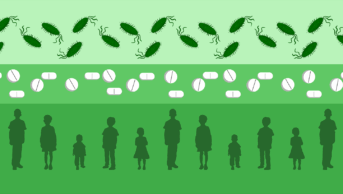
Shutterstock.com
A mix of interventions – including educational support from a pharmacist – can reduce the rate of high-risk prescribing for a specific group of patients and may lead to improved clinical outcomes, according to the results of a UK study published in The New England Journal of Medicine
[1]
.
Researchers set out to discover whether the combination of three interventions could reduce the incidence of high-risk prescribing among patients prescribed nonsteroidal anti-inflammatory drugs (NSAIDs) or selected antiplatelet agents. The study included patients with chronic kidney disease given an NSAID and patients prescribed an NSAID as well as an oral anticoagulant without being given gastro-protection.
“We found that a complex intervention that combined professional education, informatics to support patient identification and review, and financial incentives to review patients who have been exposed to high-risk prescribing led to substantial and sustained reductions in targeted high-risk prescribing,” say the researchers, led by Bruce Guthrie, professor of primary care medicine at the University of Dundee Medical School. The interventions were also associated with reductions in the rates of related emergency admissions, they add.
The study involved 33 primary care practices across the Tayside region of Scotland and 33,334 patients at risk of high-risk prescribing. The three interventions were delivered for 48 weeks and data continued to be collected for another 48 weeks after the interventions stopped. The researchers identified nine indicators of high-risk prescribing that were all linked to adverse events associated with gastrointestinal and renal events and heart failure.
Practices were paid an average £550 to take part in the study – an initial £350 and then £15 for each patient recruited. Each practice also received a one-hour education session with a pharmacist at the start of the study, supported with written material, and an individualised newsletter sent every eight weeks to update the practice on its progress.
The informatics tool flagged patients who needed a medicines review, displayed details of relevant drug histories and provided weekly updates on the rate of high-risk prescribing. GPs could clear the flag if they considered prescribing to be appropriate or by taking steps to reduce any risk identified.
The researchers found that the rate of high-risk prescribing was significantly reduced from 3.7% (1,102 of 29,537 patients at risk) immediately before the intervention started to 2.2% (674 of 30,187) at the end of the intervention (adjusted odds ratio 0.63; 95% confidence interval [CI] 0.57 to 0.68; P>0.001).
The rate of hospital admissions for gastrointestinal ulcer or bleeding also significantly reduced from 55.7 to 37.0 admissions per 10,000 person-years (rate ratio 0.66; 95% CI 0.51 to 0.86; P=0.002). The reduced rate of admissions for heart failure was also significant – falling from 707.7 to 513.5 admissions per 10,000 person-years (rate ratio 0.73; 95% CI 0.56 to 0.95; P=0.02). But the reduction in admissions for acute kidney injury was not significant, falling from 101.9 to 86.0 admissions per 10,000 person-years (rate ratio 0.84; 95% CI 0.68 to 1.09; P=0.19).
The researchers say it was impossible to identify which of the three interventions had the biggest impact, but suggest all three could be implemented across primary care systems worldwide.
“The three components of this intervention are feasible in any system in which primary care is delivered by physician-owned practices that use electronic medical records and are under contract with third-party payers, which is a common model internationally,” the team says. “However, complex interventions of this type inevitably require tailoring to context.”
Study author Tobias Dreischulte, lead pharmacist in research and development at NHS Tayside, suggests that targeting the six indicators that identify patients as being at gastrointestinal risk could “reduce the largest number of [preventable drug-related hospital] admissions”. He also points out that the direct cost of the intervention was “relatively low”.
Dreischulte says the latest findings “create strong arguments for the involvement of non-physician healthcare professionals in the review and optimisation of drug therapy to prevent unnecessary drug related harm”.
However, he stops short of suggesting which healthcare professionals should carry out the reviews.
“Which non-physician healthcare professionals should be involved and the nature of their involvement will depend both on [their] competencies and on the complexity of the particular drug therapy risks targeted,” he says.
Dreischulte also suggests the efficacy of interventions might not be sustained if the initiation and review of high-risk prescribing are conducted by different professionals.
References
[1] Dreischulte T, Donnan P, Grant A et al. Safer Prescribing — A Trial of Education, Informatics, and Financial Incentives. N Engl J Med 2016;374:1053-64. doi: 10.1056/NEJMsa1508955


